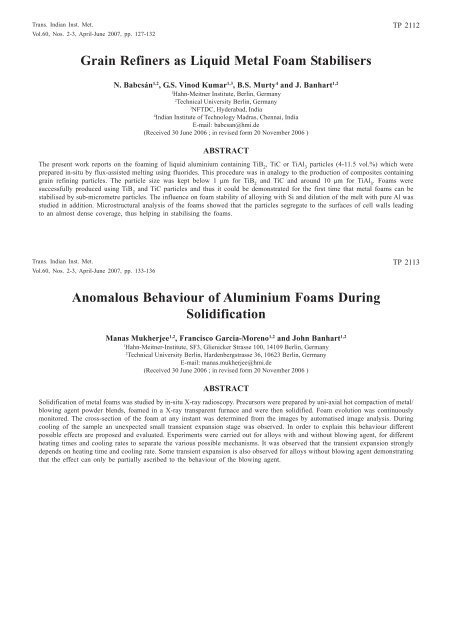Vol.60, Nos. 2-3 - Indira Gandhi Centre for Atomic Research
Vol.60, Nos. 2-3 - Indira Gandhi Centre for Atomic Research
Vol.60, Nos. 2-3 - Indira Gandhi Centre for Atomic Research
Create successful ePaper yourself
Turn your PDF publications into a flip-book with our unique Google optimized e-Paper software.
Trans. Indian Inst. Met.<br />
<strong>Vol.60</strong>, <strong>Nos</strong>. 2-3, April-June 2007, pp. 127-132<br />
TP 2112<br />
Grain Refiners as Liquid Metal Foam Stabilisers<br />
N. Babcsán 1,2 , G.S. Vinod Kumar 1,3 , B.S. Murty 4 and J. Banhart 1,2<br />
1<br />
Hahn-Meitner Institute, Berlin, Germany<br />
2<br />
Technical University Berlin, Germany<br />
3<br />
NFTDC, Hyderabad, India<br />
4<br />
Indian Institute of Technology Madras, Chennai, India<br />
E-mail: babcsan@hmi.de<br />
(Received 30 June 2006 ; in revised <strong>for</strong>m 20 November 2006 )<br />
ABSTRACT<br />
The present work reports on the foaming of liquid aluminium containing TiB 2<br />
, TiC or TiAl 3<br />
particles (4-11.5 vol.%) which were<br />
prepared in-situ by flux-assisted melting using fluorides. This procedure was in analogy to the production of composites containing<br />
grain refining particles. The particle size was kept below 1 µm <strong>for</strong> TiB 2<br />
and TiC and around 10 µm <strong>for</strong> TiAl 3<br />
. Foams were<br />
successfully produced using TiB 2<br />
and TiC particles and thus it could be demonstrated <strong>for</strong> the first time that metal foams can be<br />
stabilised by sub-micrometre particles. The influence on foam stability of alloying with Si and dilution of the melt with pure Al was<br />
studied in addition. Microstructural analysis of the foams showed that the particles segregate to the surfaces of cell walls leading<br />
to an almost dense coverage, thus helping in stabilising the foams.<br />
Trans. Indian Inst. Met.<br />
<strong>Vol.60</strong>, <strong>Nos</strong>. 2-3, April-June 2007, pp. 133-136<br />
TP 2113<br />
Anomalous Behaviour of Aluminium Foams During<br />
Solidification<br />
Manas Mukherjee 1,2 , Francisco Garcia-Moreno 1,2 and John Banhart 1,2<br />
1<br />
Hahn-Meitner-Institute, SF3, Glienicker Strasse 100, 14109 Berlin, Germany<br />
2<br />
Technical University Berlin, Hardenbergstrasse 36, 10623 Berlin, Germany<br />
E-mail: manas.mukherjee@hmi.de<br />
(Received 30 June 2006 ; in revised <strong>for</strong>m 20 November 2006 )<br />
ABSTRACT<br />
Solidification of metal foams was studied by in-situ X-ray radioscopy. Precursors were prepared by uni-axial hot compaction of metal/<br />
blowing agent powder blends, foamed in a X-ray transparent furnace and were then solidified. Foam evolution was continuously<br />
monitored. The cross-section of the foam at any instant was determined from the images by automatised image analysis. During<br />
cooling of the sample an unexpected small transient expansion stage was observed. In order to explain this behaviour different<br />
possible effects are proposed and evaluated. Experiments were carried out <strong>for</strong> alloys with and without blowing agent, <strong>for</strong> different<br />
heating times and cooling rates to separate the various possible mechanisms. It was observed that the transient expansion strongly<br />
depends on heating time and cooling rate. Some transient expansion is also observed <strong>for</strong> alloys without blowing agent demonstrating<br />
that the effect can only be partially ascribed to the behaviour of the blowing agent.
















